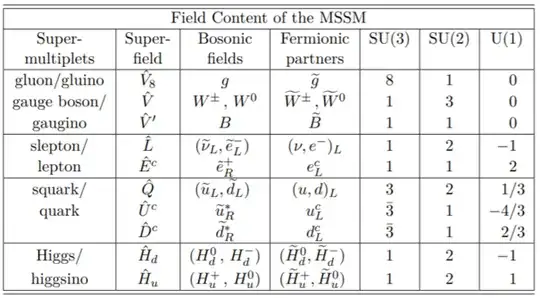From what I am aware of, the LHC has ruled out the Minimal Supersymmetric Standard Model (MSSM), or at least highly constrain it. "Minimal" means that supersymmetry is introduced into the Standard Model in the simplest way and, according to many physicists, this makes the supersymmetric model to be the most likely model. What does "simplest" mean? And why does physicists claim that this imply the model is more "likely"?
Asked
Active
Viewed 377 times
1 Answers
3
- The MSSM is "minimal" since you add the minimum number of superpartners to the existing Standard Model - one each (gauginos, squarks, sleptinos and a higgsino) - and then double the Higgs sector to have two complex Higgs doublets. The latter is needed for anomaly cancellation in triangle diagrams with internal higgsinos and also providing masses to up-type quarks. In other words, it's the most economical supersymmetric extension of the SM that results in a consistent theory. Here's the particle content, from PDG:
- The MSSM manages to make major strides in solving the hierarchy problem, exact gauge coupling unification, providing dark matter candidates and easy SUSY breaking right from the get go. It is quite difficult to get e.g. exact gauge coupling unification with further supersymmetric extensions, and naturally such models are more complicated and with more free parameters, hence the MSSM (especially nice parametric subsets of it, like pMSSM) is of great interest. It's also a base for other models, like NMSSM (where we introduce another singlet Higgs superfield) which have even less fine-tuning. However, note that other supersymmetric models do fare better apropos certain classes of astronomical and particle data, but you can read a bit about the broad status of the MSSM here: The future of supersymmetry.
Nihar Karve
- 8,672
